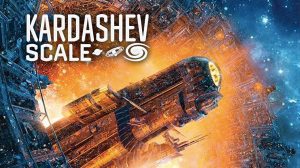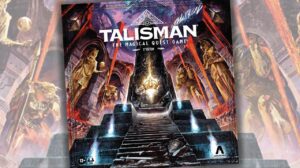I hated Dominion. Dominion convinced me that deckbuilders were boring and slow. Because of my negative experience, I avoided deckbuilders as a genre until Ascension showed up. Ascension promised a quicker game with an easy setup that can be played within 30 to 45 minutes. It was like a sexy new car at an auto show with sleek innovative features such as the random market row to buy your cards instead of fixed stacks. It worked and it got me hooked. So much so that it was one of the first card games I have ever sleeved and a younger me wrote a review on BoardGameGeek. Please don’t look.
My time with Ascension ended as soon as the official Ascension app was released. The app was so good that it made the physical version feel meaningless. It was one of the first deckbuilders to be released as an app and it did so well that a good portion of the community resided there.
Now the original crafters of this masterpiece have created yet another deckbuilder called Shards of Infinity. Unlike Ascension, this is focused on Player vs Player where the objective is to eliminate the other players instead of having the most victory points. It is also based on Star Realms, a popular deckbuilder, but with some twists to refine the formula.
Anyone who spent some time with board games is probably aware of deckbuilders and the familiar tropes are all here. You have your randomly drawn middle market to buy cards and you play all the cards in your hands to generate currency to do particular actions like attacking or buying. Like every other deckbuilder, your starting deck is crap and the first “arc” of the game is to improve your tiny little useless deck into an efficient murder monstrosity or point generating machine.
 The Body Of The Old
The Body Of The Old
Alright, so this game isn’t treading new ground at this point. It feels recycled, much like a revival of a 90s sitcom.
However, the changes are subtle to a certain extent. The common market deck isn’t big as you would think, meaning the tools available to the players are easier to familiarize and balance against each other. Each of the four factions, or colors, in this game are hyper-focused on a particular mechanism. For example, the green Undergrowth is focused on healing while the blue Order cards provide defensive measures as well as ways to generate Mastery.
Mastery? Yes, it’s a new currency that isn’t spent but accumulated. Some of the cards in your starting deck and the common market deck will become more powerful once you reach a certain threshold. Pull out the Shard Reactor and you only get 2 Gems to buy cards, unless you have 15 Mastery which now makes that 4 Gems. Slap down the Shard of Infinity and you only deal 2 damage but having at least 30 Mastery will lead you to deal Infinite damage. Ooooh.
This does mean that Mastery introduces a new method of winning without you resorting to constantly barraging your opponent with damage numbers. Heal yourself to negate their damage while slowly increasing your mastery is now a viable way to build your deck. It’s a welcome mechanism that introduces a thematic in-game timer.
Fortunately, the innovations don’t stop there. There is now a “fast play” system using the mercenary cards. Some cards in the market deck have a mercenary keyword with a red outline to visually denote itself from the other cards. When you purchase these cards, you have the option of using them as a “Fast Play” card. You play the card immediately to harvest its effects and at the end of your turn, it is removed from the game. This mechanisms introduces a way to utilize the cards in the market row, but it also allows some room for hate drafting without bloating your deck.

Hiding In Your Shell
Outside of damage, master, healing, or buying, you can also buy defensive cards. These wonderful cards with a little shield icon allow you to reduce any incoming damage. When your opponent has announced how much dealing they are sending your way, you show the card from your hand to reduce the incoming damage then it goes back into your hand. Much like the Fast Play mechanism, this is a nice simple feature.
Although not a new concept, Champions are cards that stick around from turn to turn. Usually, when you play a card, you execute its effect and it is then discarded. Champions are permanent effects that will help you out every single round but like yourself, they have their own health points. This does act as a form of defense since your opponent is forced to make a tough decision between killing your Champions or hurting you. Not new but there is a reason why this mechanism has been sitting around in almost every deckbuilder.
All these reagents fabricate a game that far outclasses Star Realms. While this sounds like praise, it isn’t. In truth, I am puzzled by the popularity of Star Realms. I have played both the physical version as well as the app. I even tried to give Hero Realms a shot and every single time I gave these games a chance, I was met with further disappointment. I wished Shards of Infinity pushed away from the Star Realms model instead of embracing it.
My last game of Shards of Infinity solidified my sour outlook of the game. The deck I was aiming for was a mix of Order and Undergrowth cards. The end goal of my deck was to be able to draw as many cards as I can per turn while healing myself and doing bits of damage. Some Undergrowth attack cards deal massive damage if your health is high enough. To keep my deck clean, I only bought a few Wraeth cards or Fast Play them to cull out the useless starting cards.
In my final turn of the game, I’ve managed to pull off 62 damage while drawing more than half of my deck. Your starting hand is always 5 cards and your starting health is 50. With my deck, I’ve managed to continuously draw, deal damage, and heal myself with barely any input on my part. Some will point out that it was my strategy that won the game, but I’ve felt that I just rigged a slot machine in my favor and got the jackpot. My victory felt empty and that’s something I should never experience in a competitive game.

Deckbuilding Is Far Too Simple
The problems with Shards of Infinity boils down to two things: Unify and mechanisms.
Unify is a system lifted straight from Star Realms. Whenever you play a card, if you play another card of the same faction, you will get a bonus on your previously played card. This system sounds decent in concept, but it becomes such a powerful influence that it sterilizes the deckbuilder portion of the game.
Any deckbuilder player will tell you the whole point of getting better cards is your turns become more efficient. With Unify, you have situations where playing a card of the same color might double the damage or give you extra healing on top of doing damage. These effects are so strong that you can hear the crack of the whip if you don’t abuse this. You are no longer building a diverse set of mechanisms that work well together. Instead, you are forced to grab more of the same color because you would lose out on these overpowering bonuses. It’s less about exploring what the game can offer and more about given a guided tour.
This isn’t to say the faction idea is a bad one. Eternals: Chronicles of the Throne is a deckbuilder that has a parallel mechanism but executed far more cleanly. Eternals still provide bonuses for playing cards of the same faction but none of the effects are ridiculously powerful. They are small rewards like a stocking stuffer during Christmas instead of something that calls attention to itself like a corrupt politician.
Mechanisms are yet another noticeable cut in Shards of Infinity’s design. Much like Star Realms, the game is more focused on throwing numbers at you instead of creating a weave of abilities to navigate through. The majority of your experience is constant arithmetic as you are adding numbers on top of more numbers. Going back to the final game I played, I was surprised that my opponent didn’t duct tape my face because I kept babbling numbers for minutes trying to recalculate the 62 damage I did to them. At least I can say this game is good if you want to practice addition for your upcoming game of Power Grid.
The whole point of deckbuilders is to utilize diverse abilities in your favor and Shards of Infinity barely has any cards that do anything more than draw cards, remove cards, or mess with numbers. The appeal of this genre is it forces you to improvise a solution based on a limited toolset. It’s almost like scrambling to the junkyard with your friends and trying to build the best machine possible yet Shards of Infinity is missing this.
As you can tell, I don’t care about this one. I’m not a big fan of Star Realms and having a spin-off of that game isn’t going to bode well with me. For the same price range, I would suggest Eternals: Chronicles of the Throne. It’s not the most original deckbuilder but it has more challenging decisions to make. If you are willing to spend a little bit extra, Dominion and Ascension are still in print with nearly a decade worth of expansions to discover. There is also Quest to El Dorado and Adventure Mart if you are looking for something outside of the standard deckbuilder format.



 The Body Of The Old
The Body Of The Old







That 62-damage turn is one of the things I like about this one (and Star Realms) – you get that ramp up to a big finale.
The cards that trigger off of mastery remind me of another Justin Gary design – the digital, lane-based card battler SolForge. There, playing cards would level them up into their silver and then gold versions. There was a tension between your immediate needs and the long-term good.
You get the same tension in SoL: do I do a little damage now, or level up mastery so my cards really kick ass in the late game? And the instant-win alternate win condition is genius.